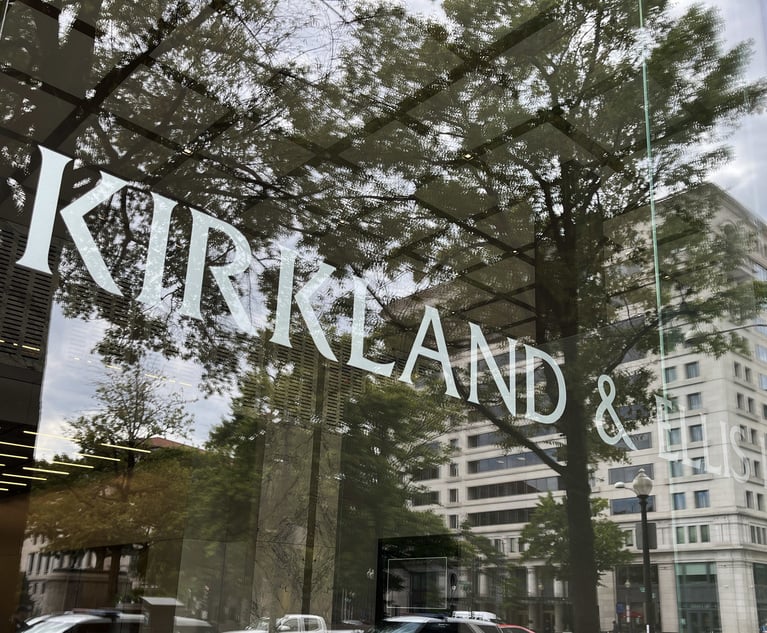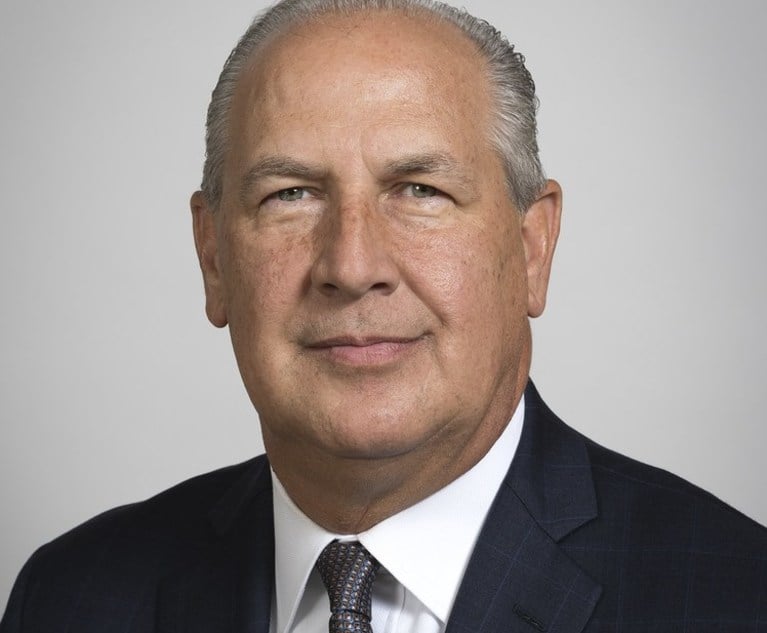When Law Firms See an Upside in Moving Downmarket
With limited market share up for grabs, more law firms are finding it can pay to cast their lines in a smaller pond.
December 11, 2017 at 04:28 PM
57 minute read
 Pictured, from left, are Randy Adler of Fox Rothchild and Mark Stewart of Ballard Spahr.
Pictured, from left, are Randy Adler of Fox Rothchild and Mark Stewart of Ballard Spahr. Editor's note: This story is the second in a series looking at how law firms fit into the middle market.
In the fight for market share, sometimes it's worth jumping into a smaller pond.
Law firms with roots in major markets are also finding ways to prosper in middle-market locations—places that would be described as the big city within their own regions, but whose population and cost of living don't come close to cities like New York, Los Angeles and Chicago.
Growing in second-tier cities often goes hand-in-hand with targeting midmarket business clients. For some firms, including Cozen O'Connor, Ballard Spahr and Fox Rothschild, that has spurred geographic expansion across the country. For others, like McCarter & English and Vorys Sater Seymour & Pease, it has meant doubling down in the region where they already have roots.
In any case, planting a flag is only step one. Firms with midmarket clients said they find success in middle-market cities only when they invest in deep community relationships.
“Big guys say they do it better, small guys say we can do it cheaper,” said Russell Gertmenian, managing partner of Columbus, Ohio-based Vorys Sater. “We get squeezed from above, and we get squeezed at the bottom, and it's why relationships matter.”
Setting Up Shop
Randy Adler of Fox Rothschild said the technology industry has ignited new growth in a number of lower-rate legal markets, including Pittsburgh, Minneapolis, Denver and Seattle, where startups are flourishing.
“The tech revolution started very much in San Francisco,” Adler said. “Eventually these things spread to all cities.”
Fox Rothschild's 22 offices are spread among the country's major population centers and midmarket cities including Denver, Pittsburgh, Minneapolis and Stamford, Connecticut. After a merger announced earlier this year, the firm has an office in Seattle too.
“I think Fox is very much ahead of the game in that it has a national brand and national name recognition, and yet a local presence in these locations,” Adler said.
Ballard Spahr has also expanded in some secondary markets recently. The firm announced in September that it will be merging with Minneapolis-based Lindquist & Vennum at the beginning of next year, and earlier this year, it opened a small office in Boulder, Colorado.
Geography isn't driving the firm's strategy, chairman Mark Stewart said, but the firm is taking advantage of opportunities in those smaller markets. Businesses in those cities are often open to having a broad and collaborative relationship with their law firm, which Ballard Spahr aims to build, he said. And Ballard Spahr's rate structure works in those markets.
“For some firms, their presence is an opportunity to take work from high-cost geographic areas to lower-cost geographic areas. … That's really not what we're talking about,” Stewart said. “We can really use some of our learning with big clients and big cities and use it in a way midsize firms can't.”
Likewise, Cozen O'Connor has established a footprint in several midmarket cities, including Minneapolis and Charlotte, North Carolina. CEO Michael Heller put it simply: firms have to be where their clients are.
“We are following our clients and their business,” he said. “We are not a firm that believes if you build it they will come, but we are a firm that says if they're there, we better be there.”
Firms that are successful with expansion in midmarket cities already have the client base there, law firm leaders said. That might be their own firm's existing clients, or the clients of a strong group the firm acquires.
Vorys Sater, for example, was able to grow successfully in Cincinnati through strategic hiring over about six years, Gertmenian said.
“That gave us a credibility that we otherwise wouldn't have had,” Gertmenian said.
For firms like Vorys Sater, that strategy takes shape on a regional basis, rather than coast-to-coast. Vorys is only about half the size of Fox Rothschild, Ballard Spahr or Cozen O'Connor in terms of lawyer head count. And unlike those firms, Vorys Sater has chosen not to open locations in most of the country's biggest cities.
Likewise, Newark, New Jersey-based McCarter & English has stayed focused on the Northeastern United States. Chairman Michael Kelly said it helps the firm to keep its overhead costs low, so it can offer reasonable rates to clients.
“We've had many opportunities to go nationwide, we've had many opportunities to merge with others … [but] most of our clients are located nearby,” Kelly said.
Right-Sized Relationships
Firm leaders said a personal touch is key to making offices in smaller markets profitable, and not every firm has mastered that.
“The vast majority [of clients] want to be able to come down and press palms with you,” Adler said. “It's really about how do you have the best relationship with your clients.”
Ballard Spahr's Stewart agreed. He said that beyond the practice of law, his firm has worked to take an active role in the communities where it has offices.
“When we make these combinations, we are making a commitment to the local community, not just to get work out of it,” he said. “These are very proud cities.”
Gertmenian, of Vorys Sater, also said firms that expand successfully in second-tier cities don't just bond with the local clients.
“You never know when you're working with a client and it would be good to call the local bank, the publisher of the newspaper, the governor, which we are able to do,” he said. “That's the defense mechanism against the big guy coming in. It gives us the ability to fend that off, defend our turf, and sell relationships.”
For that reason, he said, the biggest brand names in law won't attract much work in towns like Columbus. Similarly, he noted, Vorys Sater wouldn't do well in even smaller U.S. cities. Midmarket encompasses a lot of clients and locations, but it has its limits.
“We could go to Fargo, North Dakota, and plant a flag, and my guess is we're more sophisticated law firm than the others in Fargo, and we'll starve up there,” Gertmenian said.
It's not all about size. Fox Rothschild may have 800 lawyers, but Adler noted that the firm offers much lower rates than the richest Am Law 100 firms. Cozen O'Connor's Heller said his firm aims to keep overhead costs low to accommodate the rate needs of midmarket clients.
But for some midsize firms with midmarket clients, controlling costs means forgoing a downmarket expansion. They have a successful practice in bigger markets, and to stay that way, they must be disciplined. New York's Pryor Cashman, for instance, focuses squarely on midmarket clients, but the 166-lawyer firm is not likely to look for expansion in smaller cities, managing partner Ronald Shechtman said.
“A midsize firm has to be very careful about its overhead model,” he said. “The concept of economy of scale is turned upside down in the law firm model. It seems the bigger you are and the more offices you have, the more expensive your overhead and cost model is.”
The firm has a Los Angeles office with eight lawyers, which services a specific client need, Shechtman said. But growth in any other cities would have to carry “very compelling” economic incentives.
 Pictured, from left, are Randy Adler of
Pictured, from left, are Randy Adler of Editor's note: This story is the second in a series looking at how law firms fit into the middle market.
In the fight for market share, sometimes it's worth jumping into a smaller pond.
Law firms with roots in major markets are also finding ways to prosper in middle-market locations—places that would be described as the big city within their own regions, but whose population and cost of living don't come close to cities like
Growing in second-tier cities often goes hand-in-hand with targeting midmarket business clients. For some firms, including
In any case, planting a flag is only step one. Firms with midmarket clients said they find success in middle-market cities only when they invest in deep community relationships.
“Big guys say they do it better, small guys say we can do it cheaper,” said Russell Gertmenian, managing partner of Columbus, Ohio-based
Setting Up Shop
Randy Adler of
“The tech revolution started very much in San Francisco,” Adler said. “Eventually these things spread to all cities.”
“I think Fox is very much ahead of the game in that it has a national brand and national name recognition, and yet a local presence in these locations,” Adler said.
Geography isn't driving the firm's strategy, chairman Mark Stewart said, but the firm is taking advantage of opportunities in those smaller markets. Businesses in those cities are often open to having a broad and collaborative relationship with their law firm, which
“For some firms, their presence is an opportunity to take work from high-cost geographic areas to lower-cost geographic areas. … That's really not what we're talking about,” Stewart said. “We can really use some of our learning with big clients and big cities and use it in a way midsize firms can't.”
Likewise,
“We are following our clients and their business,” he said. “We are not a firm that believes if you build it they will come, but we are a firm that says if they're there, we better be there.”
Firms that are successful with expansion in midmarket cities already have the client base there, law firm leaders said. That might be their own firm's existing clients, or the clients of a strong group the firm acquires.
“That gave us a credibility that we otherwise wouldn't have had,” Gertmenian said.
For firms like
Likewise, Newark, New Jersey-based
“We've had many opportunities to go nationwide, we've had many opportunities to merge with others … [but] most of our clients are located nearby,” Kelly said.
Right-Sized Relationships
Firm leaders said a personal touch is key to making offices in smaller markets profitable, and not every firm has mastered that.
“The vast majority [of clients] want to be able to come down and press palms with you,” Adler said. “It's really about how do you have the best relationship with your clients.”
“When we make these combinations, we are making a commitment to the local community, not just to get work out of it,” he said. “These are very proud cities.”
Gertmenian, of
“You never know when you're working with a client and it would be good to call the local bank, the publisher of the newspaper, the governor, which we are able to do,” he said. “That's the defense mechanism against the big guy coming in. It gives us the ability to fend that off, defend our turf, and sell relationships.”
For that reason, he said, the biggest brand names in law won't attract much work in towns like Columbus. Similarly, he noted,
“We could go to Fargo, North Dakota, and plant a flag, and my guess is we're more sophisticated law firm than the others in Fargo, and we'll starve up there,” Gertmenian said.
It's not all about size.
But for some midsize firms with midmarket clients, controlling costs means forgoing a downmarket expansion. They have a successful practice in bigger markets, and to stay that way, they must be disciplined.
“A midsize firm has to be very careful about its overhead model,” he said. “The concept of economy of scale is turned upside down in the law firm model. It seems the bigger you are and the more offices you have, the more expensive your overhead and cost model is.”
The firm has a Los Angeles office with eight lawyers, which services a specific client need, Shechtman said. But growth in any other cities would have to carry “very compelling” economic incentives.
This content has been archived. It is available through our partners, LexisNexis® and Bloomberg Law.
To view this content, please continue to their sites.
Not a Lexis Subscriber?
Subscribe Now
Not a Bloomberg Law Subscriber?
Subscribe Now
NOT FOR REPRINT
© 2025 ALM Global, LLC, All Rights Reserved. Request academic re-use from www.copyright.com. All other uses, submit a request to [email protected]. For more information visit Asset & Logo Licensing.
You Might Like
View All
Trump RTO Mandates Won’t Disrupt Big Law Policies—But Client Expectations Might
6 minute read
Kirkland Lands in Phila., but Rate Pressure May Limit the High-Flying Firm's Growth Prospects
5 minute read
Montgomery McCracken Touts 'Record' Financial Performance Despite Shrinking Head Count
6 minute readTrending Stories
- 1New York-Based Skadden Team Joins White & Case Group in Mexico City for Citigroup Demerger
- 2No Two Wildfires Alike: Lawyers Take Different Legal Strategies in California
- 3Poop-Themed Dog Toy OK as Parody, but Still Tarnished Jack Daniel’s Brand, Court Says
- 4Meet the New President of NY's Association of Trial Court Jurists
- 5Lawyers' Phones Are Ringing: What Should Employers Do If ICE Raids Their Business?
Who Got The Work
J. Brugh Lower of Gibbons has entered an appearance for industrial equipment supplier Devco Corporation in a pending trademark infringement lawsuit. The suit, accusing the defendant of selling knock-off Graco products, was filed Dec. 18 in New Jersey District Court by Rivkin Radler on behalf of Graco Inc. and Graco Minnesota. The case, assigned to U.S. District Judge Zahid N. Quraishi, is 3:24-cv-11294, Graco Inc. et al v. Devco Corporation.
Who Got The Work
Rebecca Maller-Stein and Kent A. Yalowitz of Arnold & Porter Kaye Scholer have entered their appearances for Hanaco Venture Capital and its executives, Lior Prosor and David Frankel, in a pending securities lawsuit. The action, filed on Dec. 24 in New York Southern District Court by Zell, Aron & Co. on behalf of Goldeneye Advisors, accuses the defendants of negligently and fraudulently managing the plaintiff's $1 million investment. The case, assigned to U.S. District Judge Vernon S. Broderick, is 1:24-cv-09918, Goldeneye Advisors, LLC v. Hanaco Venture Capital, Ltd. et al.
Who Got The Work
Attorneys from A&O Shearman has stepped in as defense counsel for Toronto-Dominion Bank and other defendants in a pending securities class action. The suit, filed Dec. 11 in New York Southern District Court by Bleichmar Fonti & Auld, accuses the defendants of concealing the bank's 'pervasive' deficiencies in regards to its compliance with the Bank Secrecy Act and the quality of its anti-money laundering controls. The case, assigned to U.S. District Judge Arun Subramanian, is 1:24-cv-09445, Gonzalez v. The Toronto-Dominion Bank et al.
Who Got The Work
Crown Castle International, a Pennsylvania company providing shared communications infrastructure, has turned to Luke D. Wolf of Gordon Rees Scully Mansukhani to fend off a pending breach-of-contract lawsuit. The court action, filed Nov. 25 in Michigan Eastern District Court by Hooper Hathaway PC on behalf of The Town Residences LLC, accuses Crown Castle of failing to transfer approximately $30,000 in utility payments from T-Mobile in breach of a roof-top lease and assignment agreement. The case, assigned to U.S. District Judge Susan K. Declercq, is 2:24-cv-13131, The Town Residences LLC v. T-Mobile US, Inc. et al.
Who Got The Work
Wilfred P. Coronato and Daniel M. Schwartz of McCarter & English have stepped in as defense counsel to Electrolux Home Products Inc. in a pending product liability lawsuit. The court action, filed Nov. 26 in New York Eastern District Court by Poulos Lopiccolo PC and Nagel Rice LLP on behalf of David Stern, alleges that the defendant's refrigerators’ drawers and shelving repeatedly break and fall apart within months after purchase. The case, assigned to U.S. District Judge Joan M. Azrack, is 2:24-cv-08204, Stern v. Electrolux Home Products, Inc.
Featured Firms
Law Offices of Gary Martin Hays & Associates, P.C.
(470) 294-1674
Law Offices of Mark E. Salomone
(857) 444-6468
Smith & Hassler
(713) 739-1250






